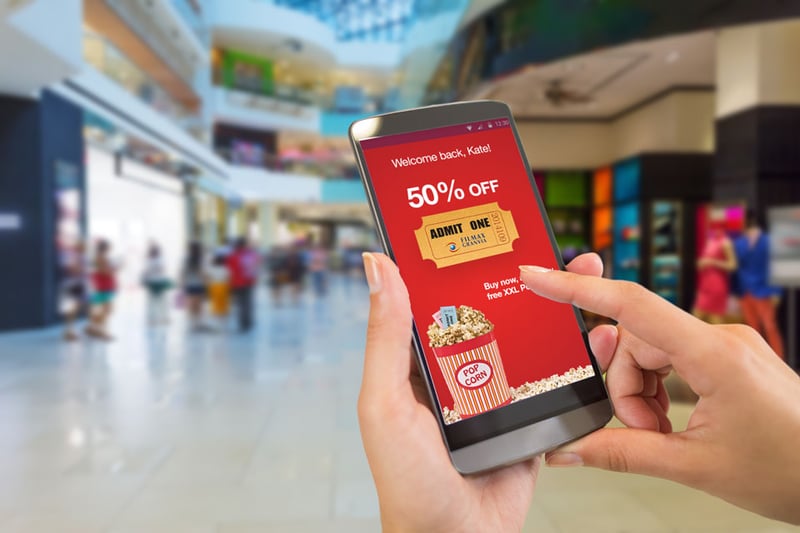No matter how closely you follow marketing articles and news, location-based marketing and its applications usually bring lots of not-so-clear technical concepts and open questions. Things get even more confusing when we talk about beacons. Read on, to discover the most common myths about this exciting technology.
Myth º1: Beacons send messages and offers
Contrary to popular belief, beacons do not deliver messages, offers or any content at all. A beacon is a BLE (Bluetooth Low Energy) hardware device that broadcasts a signal that smartphone can listen when users opt-in within a specific mobile app. When the smartphone enters a beacon range (usually up to tens of meters), it wakes up and notifies the listening app. Think of it like the beacon simply broadcasting, “I’m beacon 17” over and over again.
Technically speaking, each beacon that conforms to Apple iBeacon™ specification, emits a binary-encoded data frame that includes Universal Identifier (UUID), Major and Minor numbers. This schema is designed to ensure that each app detects only beacons that belong to a specific organization and place, while ignoring the rest.
Now, if a user has a beacon-enabled app and opted-in for location services, the app will detect the beacon signal and eventually trigger an associated action (if any). The action and its content depends completely on the app - whether it is a local push notification, fullscreen creativity or nothing at all - and its intelligence to deliver valuable information to the user.
Click here to learn How to use beacons to engage mobile users
Myth º2: Beacon-triggered messaging is intrusive to customers
Just the opposite. Proximity-based marketing is the first technology that brings to marketers the opportunity to deliver truly relevant content ‘at the right time, at the right place’. To start with, users give permission to your app which means they are interested in receiving your messages. Second proximity-based services take into account user’s context: both time and place. Beacons accuracy guarantee the latter one - the app actually ‘knows where the user is’ at a specific instant. Third and final comes from learning users behavior in-app and on your website and figuring out what might be interesting for them.
So if your digital marketing strategy combines these aspects, you will deliver amazing user experiences and bring true value to your mobile customers. Obviously, triggering welcome message each time a user enters your store, won’t do.
Myth º3: Beacons can collect information about users without permission
In opposite to passive tracking devices such as video cameras that capture user images, Wifi or Bluetooth scanners that collect MAC addresses sent from users’ smartphones (no app required), beacons are not receiving any information about users at all.
However, only when users install beacon-enabled app, enable Bluetooth and opt-in for location services on their device, the app is then able to learn about places the user visits and actions he performs within the app. Moreover the app does not need to know user’s name, ID, email address or phone number so the user identity is protected. Therefore, in the case of beacons, users have full control on their privacy by granting or rejecting permissions to a particular app.
Myth º4: Beacons are insecure
Beacon technology comes with some limited risks such as device spoofing and man-in-the-middle attacks. Despite the fact each beacon comes with a unique identifier, they can be copied and do not serve as a security mechanism. Anyone equipped with a BLE discovery app is able to discover beacon identifiers easily.
However, this doesn’t make beacon technology insecure, but indicates the security concerns that must be addressed in industrial-strength deployments.
There are enterprise-grade proximity platforms that come with security models that address these common risks. For example, one measure is the deployment of non-iBeacon compliant, proprietary firmware in beacon devices that incorporate identifier scrambling or so called rotation schemes. Each beacon keeps shifting and encrypting its identifiers and only apps enabled with secure-key schema are able to decode its signals.
Myth º5: Adopting beacon technology is a hard task for app developers
Well, it depends. If your developers plan to develop beacon and content delivery framework for iOS and Android from scratch, integrate it into your app, then build a backend cloud platform to manage, analyze and distribute the data and content, then yes, it’s a hard task.
However, with MOCA you can proximity-enable your app the same day, have your location-based marketing campaigns up and running and see ROI analytics in real time.
MOCA brings to the market the most sophisticated turnkey platform with plug-and-play approach suitable for both small and enterprise-grade apps. So, excuse us, but it is not hard task anymore.
Click here to discover How easy it is to use MOCA Proximity Marketing Platform









